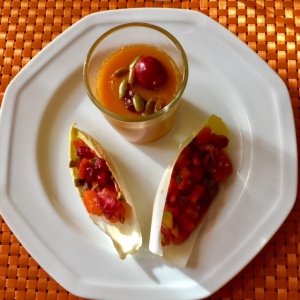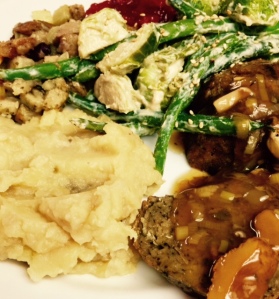So, Asian traditional medical diets turned out to be a bit more than I could handle, so that will be revisited.
In the meantime, Thanksgiving was a success. So here are a few holiday recipes to enjoy.
A fantastic resource is Zel Allen’s book Vegan for the Holidays. I adapted two recipes for the salad appetizer.

First Course: Soup and Salad
Triple P Salad Appetizer:
2 persimmon, peeled and diced
1 orange, peeled and diced
seeds of one pomegranate
1/2 C shelled, chopped pistachios
lime or lemon juice
1/4 C thinly sliced green onion
salt and pepper
Combine all ingredients in a bowl, mixing well. Taste and adjust lime juice, salt and pepper to taste. I served a dollop in a Belgian endive leaf. It could also be used to top other salad greens, mixed with quinoa for a grain salad, or by itself.
Squash Soup
1 onion chopped
1 carrot chopped
1 stalk celery chopped
1/3 C yellow split peas
1/2 t ground turmeric
4 C veg stock
1 lb. chopped squash of choice (I used butternut)
1 pear peeled and chopped
1 green apple peeled and chopped
1 T each fresh mince turmeric and ginger
salt
Saute the onion, garlic, carrot, and celery until onion softens. Add ground turmeric and cook a little longer. Add split peas, stir a bit to coat them. Add enough stock to cover, bring to a boil, then reduce to a simmer. Cook until peas start to break down, adding more stock or water as needed, about 45 minutes. When the peas are breaking apart, add the remaining ingredients and cook until squash and fruit are well done. Puree, and add salt to taste.

Main Course
Tattoos and Neeps
I’ve enjoyed mixing potatoes and turnips in various dishes for awhile, so decided to mash them. Didn’t realize that made a traditional Scottish dish.
4 yukon gold potatoes peeled or not chunked
1 small turnip peeled and chopped
1 clove garlic
1 t prepared horseradish
1/4 C nutritional yeast
liquid for mashing (broth, soy milk etc.)
salt and pepper
Throw the roots in a slow cooker and cook until done. They can finish early and sit there with no harm done for a long time. When ready to eat, add seasonings and enough liquid to mash to desired consistency.
Seitan Mushroom Loaf
I used Susan Voisin’s recipe. It was my first time making seitan myself, and it came out pretty good. A little dry, but that may have been due to some timing difficulties with carnie dishes resulting a little too much oven time.
I topped it with Mary McDougall’s Marsala Mushroom Sauce, but subbed Madeira.
With some steamed green beans and brussels sprouts and my niece’s cranberry sauce, it was awesome. I kept eating leftovers for every meal until they were gone.



